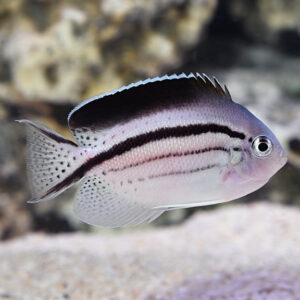Tank Bred Male Kuda Seahorse, Hippocampus kuda, also go by the name Spotted seahorse. These fish make are great options for marine tanks and are fun to keep.
Seahorses get their name from their elegant, elongated snout and curved neck which resembles a horse. In fact, their Etymology is “horse” (hippos) and “sea monster” (kámpos)
Seahorse, pipefish and sea dragons all belong to the Syngnathidae family. These ray finned fish have an unusual body plan. For instance, Kuda seahorses swim vertically in the water, rather than horizontally. An adaptation thought to help them to hide in seagrasses. Seahorses use their dorsal fin for forward motion, while other ray finned fish use their tail and caudal fin. Instead of a caudal fin, Seahorses have a flexible tail they use for grasping.
Kuda Seahorse Male Tank Bred Ecology.
Our Kuda Seahorses have been born in captivity. In the wild, Kuda Seahorses occur in the Indo-Pacific Ocean. They live around India, Pakistan, Japan and Hawaii. These seahorses have an extensive range. They inhabit estuaries and on seawards reefs, living amongst algae and seagrass. Some have even been found far offshore in floating Sargassum.
Arguably, seahorses are most famous for their unusual reproduction. Courtship can include dances and colour changes depending on the species. The female will deposit her eggs in to a brood pouch on the males ventral side. He will then fertilize and carry his eggs. For Male Kuda seahorses, it takes around 20-28 days for the babies to be born, although temperature does have an effect.
Spotted Seahorse, Hippocampus kuda, in the aquarium.
It is important to have plenty of nooks or crannies where your Tank bred Male Kuda Seahorse can anchor itself and feel at home.
Seahorses do best when fed a varied diet. Here they are eating frozen Mysis, frozen brineshrimp, frozen copepods, ocean nutrition fish eggs. We enrich all our frozen food with seachem garlic guard and Atvitol vitamins. These are imperative for keeping fish healthy by providing them with the nutrition otherwise lost in frozen food. In doing so, these additives support their immune systems and increase longevity.
In addition, Tank bred Male Kuda Seahorses will also eat live foods, such as copepods and amphipods, that can be cultivated in attached refugium. They will even occasionally go after river shrimp, which can be interesting to watch. Our seahorses are adapted to aquarium life before being offered up for sale. Meaning they are eating frozen food when they leave us.
You can keep Tank bred Male Kuda Seahorses in pairs or groups. They are not the fastest of swimmers so keepers may wish to use a feeder or tweezers. Feel free to give us a call for advice on a seahorse set up and keeping.





Reviews
There are no reviews yet.